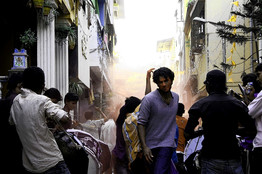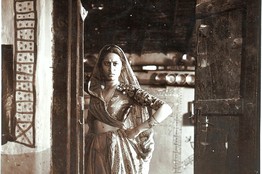
| Previews |
| online.wsj.com For Every Screen, a Worthy Film NOVEMBER 10, 2010 |
By VIBHUTI PATELOn Wednesday, the 10th annual Mahindra Indo-American Arts Council Film Festival will open at the SVA cinemas in Chelsea—the fifth South Asian film festival to open in the area in just two months. Each fall, these festivals overlap, competing for the same films, audiences and media attention, with each claiming to offer a distinctive focus. The I-View Film Festival, organized by Engendered, an arts organization specializing in gender issues, ran in September, followed by the Sikh International Film Festival. Then in October, the New Jersey Independent South Asian CineFest screened women's films, and the South Asian International Film Festival (SAIFF) presented edgier fare by younger filmmakers.  Sendhil Ramamurthy in 'Noise,' the opening film of the Mahindra Indo-American Arts Council Film Festival. The oldest of these, MIAAC was launched by socialite Aroon Shivdasani, the founder of the Manhattan-based Indo-American Arts Council, following Mayor Rudolph Giuliani's call to reinvigorate the city in the wake of the attacks of September 11, 2001. "That first year," Ms. Shivdasani said, "IAAC showed six diaspora films over one weekend." The festival opened with a tip of the hat to the iconic Merchant-Ivory production company and closed with Mira Nair's "Monsoon Wedding," but the rest, Ms. Shivdasani conceded, were "not mature films." Six years later, Mahindra and Mahindra CEO Anand Mahindra, who had majored in film at Harvard, was persuaded by Ms. Nair to invest in IAAC's festival. "We went into this to introduce our brand to a high-profile New York population, figuring it would be relevant to the diaspora community," Mr. Mahindra said. "As Indian cinema began migrating from an ethnic audience to garner mainstream viewers, our brand would benefit." And now? "Those interested in South Asian cinema will judge what MIAAC has achieved." In fact, in the past four years, MIAAC has grown into the area's most mainstream Indian film festival, offering features, documentaries, shorts and indies in numerous Indian languages and from various countries including Britain, Australia, Israel and Canada. The growth has led not only to a wider range of films, but to new partnerships and inroads to American audiences. Evidence of that will begin Thursday, when the Film Society of Lincoln Center joins with MIAAC to present a weeklong tribute to the late Indian actress Smita Patil. "MIAAC will help us introduce recent Indian cinema into our menu," said the Film Society's program director, Richard Peña. "Those films will be channelled into programs like 'New Directors, New Films' and the New York Film Festival. As partners, we're always fully involved: With our input, we'll bring MIAAC greater organization."  The late actress Smita Patil, who will be jointly feted by MIAAC and the Film Society of Lincoln Center. That spirit of partnership now pervades the community of local South Asian film festivals. The South Asian International Film Festival is presented by HBO. And the 3-year-old I-View festival, which concentrates on political films with a broad regional range including Sri Lanka, Bangladesh, Pakistan and Nepal, is presented each September in part by Asia Society, "I-View has an international perspective, so we wanted to support their work," said Rachel Cooper, Asia Society's director of cultural programming. "It generates phenomenal excitement and pride in young people." MIAAC is more specifically India-oriented and has premiered hit films like Deepa Mehta's "Water," Ms. Nair's "Namesake" and Danny Boyle's "Slumdog Millionaire." This year's opening film, "Noise," directed by Raj Nidimoru and Krishna DK, two young filmmakers with big-name Indian producers, is informed by life in the States. Other highlights include "Natvar Bhavsar: Poetics of Color," a short about a New York painter made by SoHo gallery owner Sundaram Tagore, and "Rafting to Bombay," an Israeli film about terrorism in Mumbai's Chad House. "MIAAC is a serious American festival getting critical recognition," said the festival's program director, Somi Roy. An established curator, Mr. Roy said he looks for entertainment value and the historical element. "There is not one 'Indian film,' but many kinds," he said. "India's industry is bigger than Hollywood." Big enough to support what is now a growing cycle of Indian and South Asian film festivals in the area. With a booming industry and more American outlets to showcase it, more filmmakers are coming to promote their work in the West. It's an historic opportunity, but one with obvious challenges. "The real problem in having so many festivals is that they confuse filmmakers," Ms. Cooper said. "Where do they send their films? They want not just diaspora audiences but global viewers in New York." Of course, she added, "Competition is not bad; it's American. There's enough space for all—though not all in November!" |
| Source: http://online.wsj.com/article/SB10001424052748704635704575604572985251174.html |